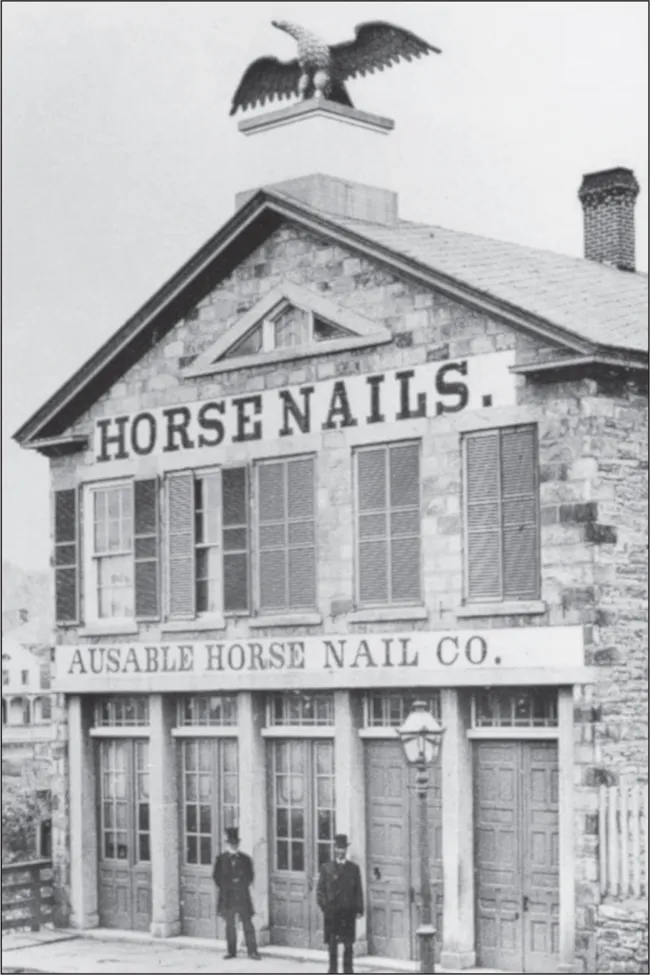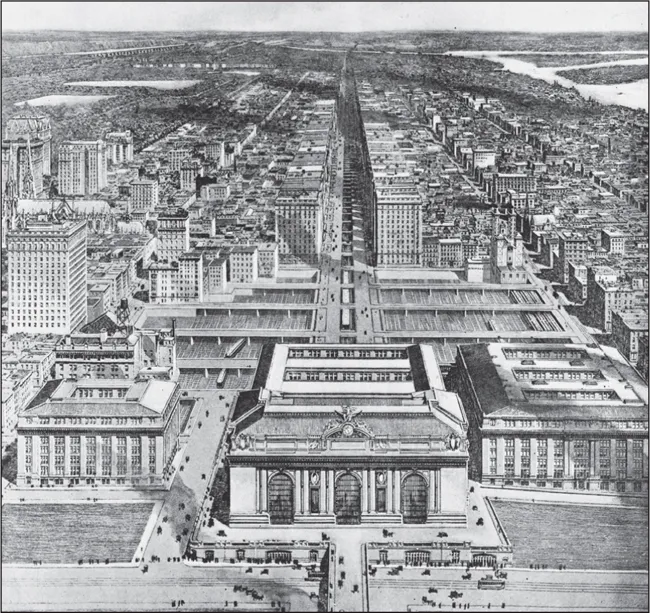![]()
One
GRAND CENTRAL
TERMINAL STATUARY
In 1854, the City of New York banned the use of steam locomotives in Lower Manhattan below Forty-Second Street, necessitating that trains below that point be pulled by horses. In 1871, Commodore Cornelius Vanderbilt, New York Central Railroad president, built a huge train station with frontage on Forty-Second Street, with Park Avenue meeting at its center. This 1890 image shows the building looking northeast, along Forty-Second Street. This building became known as Grand Central Depot. (Courtesy of the Library of Congress.)
This c. 1871 drawing shows Grand Central Depot looking northwest. This building was divided into three sections, each serving three railroads: New York Central & Hudson River Railroad on the left, New York & Harlem Railroad in the middle, and New York & New Haven Railroad on the right. The depot opened on October 9, 1871, and was found to be ill-designed. Getting from one section to another was most inconvenient.
This drawing of Grand Central Depot, facing northeast, appeared in the February 3, 1872, edition of Harper’s Weekly. The depot building was an L-shaped, three-story, redbrick structure. It took two years to build and was one of the most elegant buildings in the city. Five towers were on the building, with the Forty-Second Street center tower having large clocks on all sides. Trains entered and departed at ground level, heading north along what is now Park Avenue.
Located in the Winterthur Museum in Delaware is a 3-foot-high wooden eagle sculpture with a 14-foot wingspan. For decades, museum records identified this sculpture as being “from the first New York Central Railroad station in Manhattan.” This photograph was taken at the fifth-floor conservatory on February 13, 1997. An extensive search was unable to reveal any photographs or descriptions of this sculpture being at Grand Central Depot.
Recently, the Winterthur Museum has removed reference to Grand Central Depot from their object report and is now of the belief that the sculpture was originally on top of the Ausable Horse Nail Company building in Keesville, New York. This is an undated photograph of the wooden eagle on top of the building, which shows a striking similarity to the eagle at the Winterthur Museum. The building is still there, but the eagle is long gone, its fate unknown. (Courtesy of Steve Engelhart.)
By the 1890s, Vanderbilt’s railroads had grown and the depot was serving almost 500 trains per day. In the late 1890s, William Vanderbilt, who took over as railroad president when his father died in 1877, commissioned New York architect Bradford Lee Gilbert to design a renovation of the depot building. The three separate waiting rooms were combined into one large room, and three floors were added to accommodate the offices of the railroad’s growing staff. Four towers were placed on the roof, with cast-iron eagle sculptures on the tower corners. The redbrick facing was replaced with stucco, and the building took on an entirely different appearance. This drawing, with a view facing east, appeared in the February 5, 1898, edition of Harper’s Weekly at the time of the opening of the renovated building. The street running from left to right is Vanderbilt Avenue, which runs into Forty-Second Street at right. This renovated structure became known as Grand Central Station.
Viewed looking west on Forty-Second Street, the main entrance to Grand Central Station appears quite busy. Horse-drawn carriages and wagons, as well as trolley cars, are the vehicles of the day. The tower at the corner of Vanderbilt Avenue and Forty-Second Street can be seen, with two of the cast-iron eagles in view. (Courtesy of the Library of Congress.)
This photograph, taken from the corner of Park Avenue and Forty-Second Street, shows the tower with eagles at the corner of Vanderbilt Avenue and Forty-Second Street. The Manhattan Hotel is in the background. The second trolley in the foreground is being pulled by two horses. The horse-drawn carriages and trolleys connected the railroad passengers to the city, still concentrated to the south. (Courtesy of the Library of Congress.)
This is probably one of the best views of the cast-iron eagles as they adorned the station roofline. It is not known how many eagles were on the building, but the common estimates are 10 or 11. The sculptor is also a mystery. Some of the eagles faced forward, while others faced either left or right. (Courtesy of the Library of Congress.)
The January 17, 1903, edition of Scientific American had a drawing of Grand Central Station on the cover, showing the underground subway tracks. The terminal of the Park Avenue spur of the Third Avenue elevated subway system is at right. Beyond the subway terminal is the 1885 annex to Grand Central Depot, which survived until 1910.
In 1901, the Pennsylvania Railroad started building tunnels and a huge railroad station on the west side of Manhattan. The New York Central Railroad, not to be outdone by the PRR, decided to replace the 1898 Grand Central Station building with a larger and more elegant structure. This drawing, which appeared in the June 17, 1911, edition of Scientific American, shows the proposed new building—Grand Central Terminal.
Designed by the architectural firms of Reed & Stem and Warren & Wetmore, Grand Central Terminal was of the Beaux-Arts style, opening on February 2, 1913. It was constructed on a 17-acre plot that required dozens of buildings to be razed. This photograph was taken shortly after the terminal opened, at a time prior to Park Avenue being elevated to go around the building. (Courtesy of the Library of Congress.)
Viewed looking northwest, this image shows Park Avenue after it was raised, which allowed traffic to go around the building. It can be seen that the city north of Grand Central Terminal was devoid of any large buildings. The major population of...













